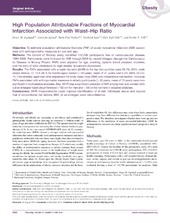High population attributable fractions of myocardial infarction associated with waist-hip ratio
Egeland, Grace M.; Igland, Jannicke; Vollset, Stein Emil; Sulo, Gerhard; Eide, Geir Egil; Tell, Grethe Seppola
Peer reviewed, Journal article
Published version

Åpne
Permanent lenke
https://hdl.handle.net/1956/15594Utgivelsesdato
2016-05Metadata
Vis full innførselSamlinger
Originalversjon
https://doi.org/10.1002/oby.21452Sammendrag
Objective: To estimate population attributable fractions (PAF) of acute myocardial infarction (AMI) associated with anthropometric measures by sex and age. Methods: The Cohort of Norway study identified 140,790 participants free of cardiovascular disease, 1994-2003. Participants were followed for AMI through 2009 by record linkages through the Cardiovascular Disease in Norway Project. PAFs were adjusted for age, smoking, systolic blood pressure, diabetes, and the ratio of total cholesterol to high-density lipoprotein cholesterol. Results: The PAFs associated with a waist–hip ratio (WHR) in the top two quintiles were 26.1% (95% confidence interval, CI 14.6–36.1) for middle-aged women (<60 years, mean of 41 years) and 9.3% (95% CI 3.0– 15.1) for similarly aged men after adjustment for body mass index (BMI) and conventional risk factors. However, PAFs associated with anthropometric measures in elderly participants ( 60 years, mean of 70 years) were nonsignificant in multivariable analyses. Also, WHR was a significant predictor of AMI among men and women without an enlarged waist circumference (<102 cm for men and<88 cm for women) in adjusted analyses. Conclusions: WHR measurements could improve identification of at-risk individuals above and beyond that of conventional risk factors, BMI, or an enlarged waist circumference.
